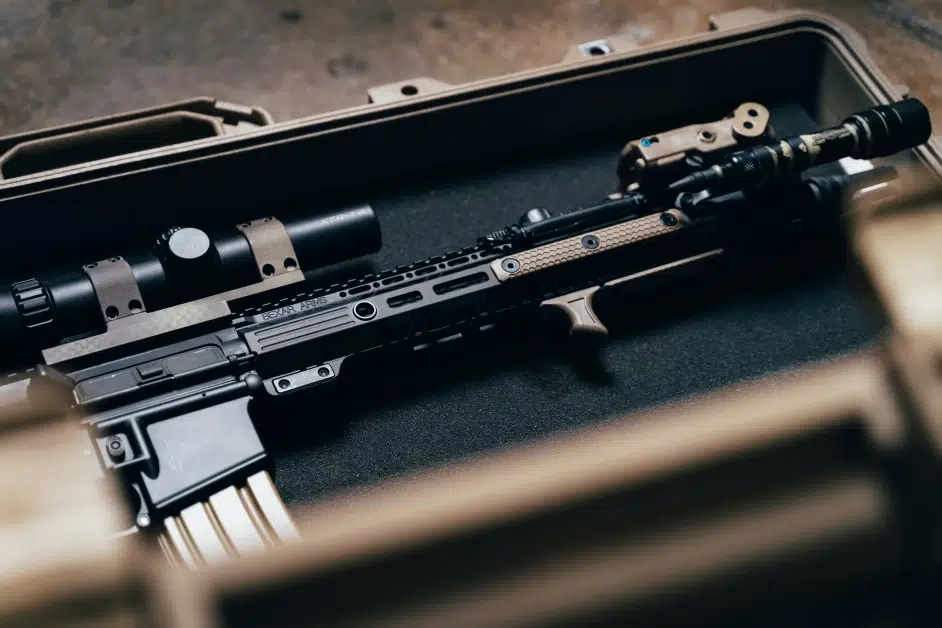


Free Shipping | 99% of all stands ship within 24 hours
We appreciate you sharing this:


We appreciate you sharing this:

Categories:
The AR-15 rifle has become one of the most recognizable guns in the United States, prompting passionate debates over its legality and its place within American gun culture. This semi-automatic rifle, originally designed for military use, has gained immense popularity among civilian gun enthusiasts since its introduction to the civilian market in the 1960s. With its sleek design, lightweight frame, and customizable features, the AR-15 has become a symbol of personal defense and recreational shooting for millions of Americans.
At the heart of these debates lies the Second Amendment to the United States Constitution, which guarantees citizens’ right to bear arms. Advocates argue that owning an AR-15 is an exercise of this constitutional right and serves as a means to protect oneself and loved ones from potential threats. However, critics express concerns about public safety and believe that stricter regulations on guns like the AR-15 are necessary to prevent mass shootings.
Understanding both legal and political perspectives surrounding this contentious issue is crucial for comprehending America’s complex relationship with guns. The debate surrounding the AR-15 extends beyond mere gun ownership; it delves into questions about individual liberties versus societal well-being, self-defense versus public safety, and personal identity tied to gun ownership. This text aims to provide an in-depth exploration of both legal interpretations regarding the Second Amendment’s application to weapons like the AR-15 as well as political arguments surrounding its regulation.
The Second Amendment of the United States Constitution has been a subject of extensive debate, with differing interpretations and legal implications. To fully comprehend its meaning, it is essential to explore the historical context surrounding its inception and analyze the various perspectives that have shaped its interpretation. The Second Amendment, ratified in 1791, states: “A well-regulated Militia, being necessary to the security of a free State, the right of the people to keep and bear Arms shall not be infringed.”
At its core, this amendment seeks to address two distinct aspects – the importance of a well-regulated militia and an individual’s right to possess guns. Historically, during the late 18th century when this amendment was drafted by James Madison as part of the Bill of Rights, militias played a crucial role in defending against potential threats from foreign powers or internal unrest.
The framers believed that maintaining an armed citizenry would provide a means for self-defense and serve as a check against potential tyranny. Interpretations of this amendment have evolved over time. Some proponents argue that it safeguards an individual’s inherent right to possess guns for self-defense or recreational purposes. Others emphasize its collective nature, asserting that it only protects arms possession within organized state militias rather than individuals.
Additionally, Supreme Court decisions such as District of Columbia v. Heller (2008) have further fueled debates about whether restrictions on gun ownership can be imposed without infringing upon constitutional rights.
The interpretation of the Second Amendment and its relationship to guns has been a hotly debated topic in American jurisprudence. Over the years, the Supreme Court has taken up several cases that have shaped the legal landscape surrounding gun rights and specifically addressed the constitutionality of restrictions on guns, including the popular AR-15 rifle. In 2008, the landmark case District of Columbia v. Heller brought forth a pivotal decision regarding individual gun ownership rights.
The Court held that the Second Amendment protects an individual’s right to possess guns for self-defense within their home. This ruling marked a significant departure from previous interpretations, which primarily focused on collective rights related to militia service. However, despite recognizing an individual’s right to possess guns, the Heller decision did not establish an absolute prohibition on regulation. The Court explicitly stated that certain restrictions could still be imposed without infringing upon constitutional rights.
These may include regulations related to dangerous and unusual weapons or prohibiting gun possession by felons or mentally ill individuals. Another crucial case came in 2010 with McDonald v. City of Chicago, where the Court determined that the Second Amendment is incorporated against state and local governments through the Fourteenth Amendment’s due process clause. This ruling clarified that states cannot entirely disregard an individual’s right to bear arms.
While these decisions affirm an individual’s right to possess guns under certain circumstances, they also recognize that reasonable regulations can be implemented without violating constitutional principles.
The AR-15 rifle, originally developed by Armalite in the 1950s, has become a significant part of American gun culture. Its popularity stems from its versatility, accuracy, and ease of use. However, this gun has also been at the center of intense controversy due to its involvement in numerous high-profile mass shootings. One reason for the AR-15’s popularity is its customizable nature.
Gun enthusiasts can modify the rifle with various accessories such as scopes, grips, and stocks to suit their preferences and shooting style. Additionally, its semi-automatic firing mechanism allows for rapid follow-up shots, making it a preferred choice for sport shooting and self-defense. However, the AR-15’s notoriety largely arises from its association with mass shootings. Tragic incidents like those at Sandy Hook Elementary School in 2012 or Marjory Stoneman Douglas High School in 2018 involved perpetrators using this weapon.
Due to these events, many argue that the easy accessibility of such a powerful gun contributes to the frequency and lethality of mass shootings in America. The debate surrounding the AR-15 also extends to Second Amendment rights. Advocates argue that banning or heavily regulating this gun infringes upon their constitutional right to bear arms. They contend that focusing on mental health issues rather than restricting access to guns would be a more effective approach to preventing violence.
Conversely, opponents believe stricter regulations are necessary to prevent further tragedies.
The political debates surrounding the AR-15 rifle have become increasingly intense, with advocates on both sides passionately defending their positions. On one side of the spectrum, proponents of stricter gun control argue that the AR-15 should be heavily regulated or banned altogether due to its potential for misuse and high lethality in mass shootings. They assert that such guns pose a significant threat to public safety and that limiting access to them is necessary to prevent further tragedies.
Opposing this viewpoint are those who emphasize the importance of upholding Second Amendment rights. They argue that the ability to possess guns, including those like the AR-15, is a fundamental aspect of American liberty and essential for self-defense against potential threats – both from criminals and a potentially tyrannical government. For these individuals, any attempt at restricting access or imposing stringent regulations on guns infringes upon their constitutional rights.
This polarized debate often becomes entangled in discussions about mental health, criminal justice reform, and overall societal safety measures. Those advocating for stricter gun control measures believe that focusing solely on gun restrictions is inadequate without addressing underlying issues such as mental health treatment availability and comprehensive background checks. On the other hand, proponents of Second Amendment rights argue that responsible law-abiding citizens should not be punished for the actions of a few criminals or mentally unstable individuals.
Ultimately, finding common ground between these two perspectives remains challenging due to deeply ingrained beliefs and values surrounding personal freedoms versus collective security.
The ownership and regulation of the AR-15 rifle, a popular semi-automatic gun, vary significantly across different states within the United States. While the Second Amendment grants citizens the right to bear arms, individual states possess the authority to impose their own laws and restrictions on guns. Consequently, this has resulted in a patchwork of regulations regarding AR-15 ownership at the state level.
Several states have enacted strict laws surrounding AR-15 ownership. For instance, California imposes some of the most stringent regulations in the country. The state requires individuals to obtain a Guns Safety Certificate before purchasing any gun, including an AR-15. Moreover, California prohibits certain features on these rifles such as detachable magazines and pistol grips. In contrast, other states have adopted more permissive stances towards AR-15 ownership.
In Texas, for instance, there are limited restrictions on these rifles. Residents are not required to obtain licenses or permits specifically for owning an AR-15. Similarly, Arizona allows individuals to purchase and possess these guns without any additional requirements beyond federal background checks. Furthermore, some states have implemented unique measures that fall between stringent and lenient regulations. New York has established a permitting system for assault weapons like the AR-15 which involves background checks and registration with local law enforcement agencies.
Given this diverse landscape of state-level regulations governing AR-15 ownership, it is crucial for individuals to familiarize themselves with their respective state’s laws before purchasing or possessing such guns.
In recent years, the United States has witnessed a disturbing surge in mass shootings, prompting intense debates about gun control measures and their relation to the Second Amendment. These tragic events, such as the Parkland shooting in 2018 and the Las Vegas massacre in 2017, have ignited widespread public outcry and demands for tighter regulations on guns.
The frequency and scale of these mass shootings have exposed significant flaws in the current gun control system. Advocates argue that unrestricted access to guns, including semi-automatic rifles like the AR-15, has contributed to these devastating incidents. Critics of current gun laws emphasize that it is far too easy for individuals with malicious intent to obtain high-capacity weapons capable of causing immense harm within seconds.
In response to these tragedies, there has been a growing chorus of voices calling for stricter gun control measures. Many propose implementing comprehensive background checks on all gun purchases, closing loopholes that allow individuals to acquire guns without proper scrutiny. Others advocate for banning assault weapons altogether or limiting magazine capacities as a means to curtail potential damage during mass shootings.
However, opponents argue that such measures infringe upon citizens’ Second Amendment rights by restricting their ability to defend themselves against potential threats or tyrannical governments. They contend that responsible gun ownership should not be penalized due to the actions of a few deranged individuals.
As calls for stricter gun control measures intensify following each new incident of mass violence, finding common ground between those advocating for enhanced regulation and those defending individual liberties remains an ongoing challenge within American society.
In conclusion, the topic of the AR-15 and its relationship with the Second Amendment presents a challenging dilemma in terms of balancing individual rights with public safety. The legal and political perspectives surrounding this issue highlight the need for a thoughtful approach that takes into account both sides of the argument.
From a legal standpoint, courts have consistently recognized that individuals have a right to bear arms under the Second Amendment. This includes ownership of guns such as the AR-15, which is widely available and popular among gun enthusiasts. However, this right is not absolute and can be subject to reasonable regulation in order to ensure public safety.
On the political front, there are ongoing debates about implementing stricter gun control measures in response to mass shootings and rising gun violence rates. These discussions often center around whether or not certain guns, like the AR-15, should be banned or subject to additional restrictions.
Finding a balance between individual rights and public safety requires careful consideration. It necessitates exploring measures that promote responsible gun ownership while also addressing concerns about potential misuse or harm caused by certain guns. This could involve comprehensive background checks, mandatory training programs for gun owners, or restrictions on high-capacity magazines.
Ultimately, achieving this balance requires an open dialogue between lawmakers, legal experts, law enforcement agencies, and citizens on both sides of the issue. Only through thoughtful deliberation can we hope to develop policies that respect individual rights while prioritizing public safety in an ever-evolving society.